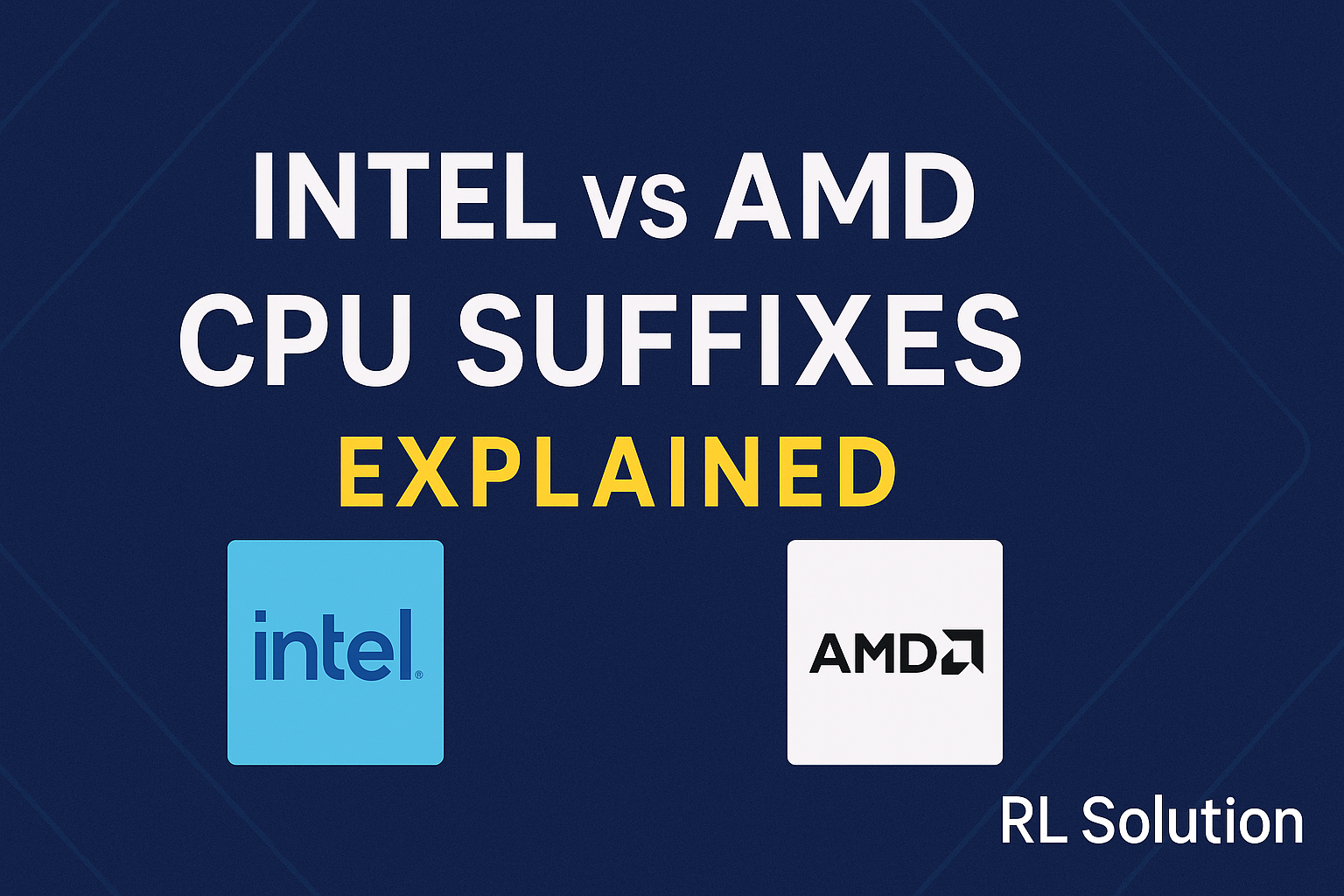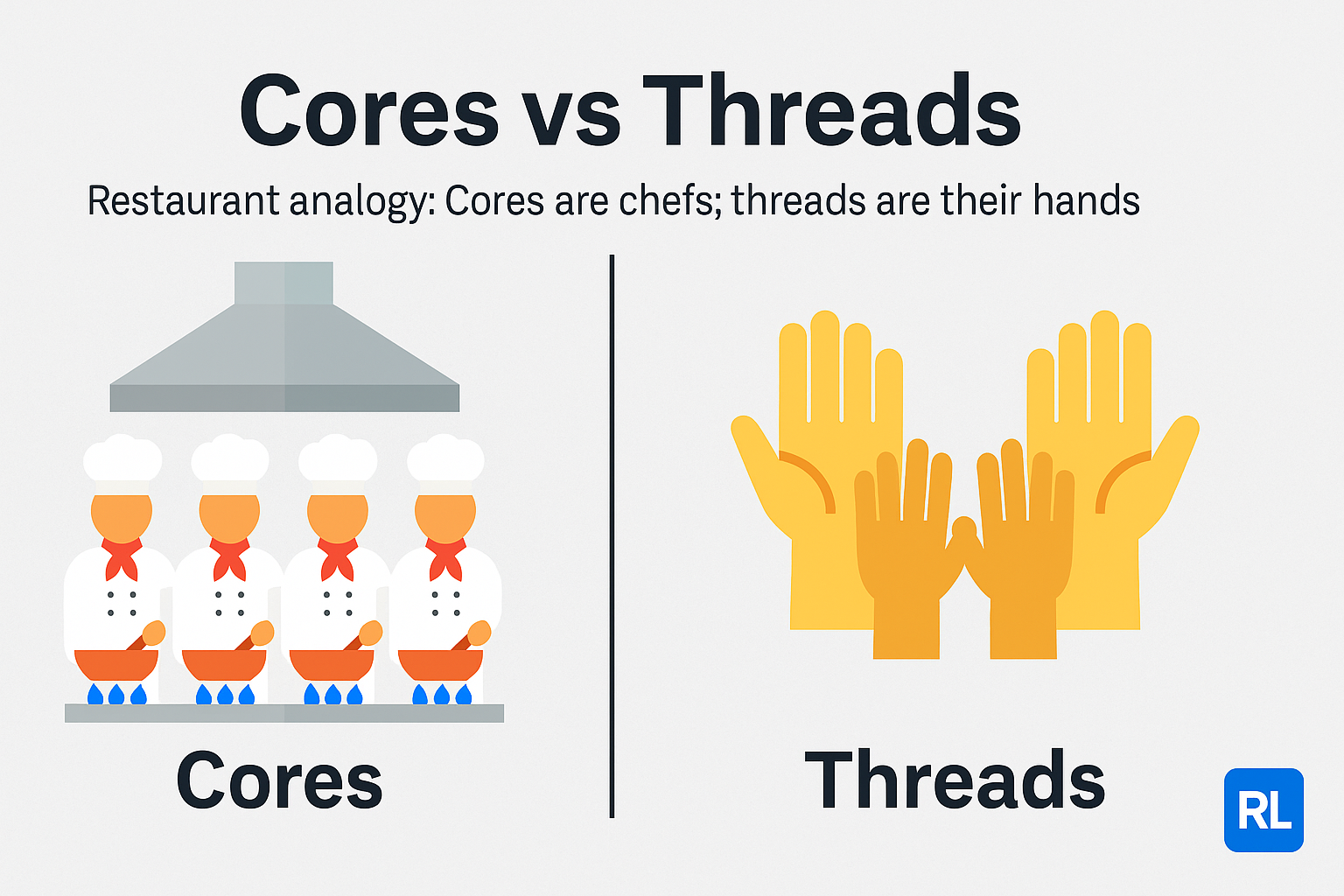👋 Welcome to RL Solution!
Hey there! If you’re here, you’re probably scratching your head over names like:
- Intel Core i5-12400F
- Ryzen 5 5600G
- Core i9-12900K
What do those suffixes mean? What’s the difference between a K and a KF?
Should you care about them as a student, gamer, or developer?
Absolutely. These tiny letters can make a huge difference in price, performance, power, and compatibility.
So, let’s break it down.
🚀 Why CPU Suffixes Matter More Than You Think!
Think of suffixes like feature tags or mode switches. A Core i5 isn’t just a Core i5 — its suffix changes everything.
They tell you:
- If the chip includes a built-in GPU
- If it’s designed for overclocking or energy savings
- If it’s binned for better performance
- And whether it suits gaming, content creation, or business
Getting this wrong could mean:
- Your new PC won’t boot (no GPU!)
- You overspend on power you’ll never use
- You miss out on features you actually need
🧩 Full Intel & AMD CPU Suffix Comparison Table
| Brand | Suffix | Has iGPU | Use Case | Best For | Pros | Cons | 💰 Tier |
|---|---|---|---|---|---|---|---|
| AMD | GE | Radeon | Low-Powe (35W) | Office PCs, HTPCs | Cool & efficient | Lower Power | $ Low |
| Intel | T | UHD | Energy-Saving | Silent, Compact PCs | Cool, Quiet | Reduced Speed | $ Low |
| Intel | F | – | No Graphics | GPU Builds | Lower Cost | Need GPU to Boot | $ Low-Mid |
| AMD | – | – | Base CPU | Gamers with GPU | Affordable | No Graphics | $$ Low-Mid |
| AMD | G | Radeon | APU | Budget Gaming | iGPU on-board | Limited Power | $$ Mid |
| Intel | – | UHD | Mainstream | Light Gaming | Plug & Play | No OC Support | $$ Mid |
| AMD | X | – | Tuned CPU | Gaming, Multitasking | Hogh Clock Speed | Needs Cooling | $$ Mid-High |
| Intel | K | UHD | Overclocking | Gamers, Enthusiasts | Max Performance | Needs Z-Board | $$$ High |
| Intel | KF | – | OC + No Graphics | GPU-Based System | Same as K but Cheaper | Needs GPU | $$$ High |
| AMD | XT | – | Higher Binned | Peak Single-Core Users | Boosted Performance | Minimal Upgrade | $$$ High |
| AMD | WX | – | Workstations | CAD, VFX, Rendering | Many Cores | Pricey | $$$$ Very High |
| Intel | S | UHD | Limited Edition | Top Bin Seekers | Top Specs | Rare, Expensive | $$$$ Very High |
| Intel | E | – | Embedded | Industry Use | Long Lifecycle | Not for PC Users | $$$$$ Niche |
🧠 Who Should Use Which CPU?
Think Let’s simplify it with real people in mind:
🎓 Students & Beginners
- Go for: AMD G-series or Intel without suffix (has graphics built in)
- Why: No need for GPU, budget-friendly, less hassle
🎮 Gamers
- Go for: AMD X / XT or Intel K/KF
- Why: Better clocks, overclocking, top-tier gaming performance
🧑💻 Developers & Coders
- Go for: AMD X / XT or Intel K for build-heavy environments
- Bonus Tip: If you’re compiling in C++/Java, prioritize multi-threading and cache size
🏢 Office / Media Center PCs
- Go for: Intel T or AMD GE
- Why: Efficient, quiet, perfect for compact builds
🔬 Real CPU Suffix Example Breakdown
Let’s take a few popular processors and decode them:
🔍 Intel Core i5-12400F
- F = No iGPU
- Ideal for gaming PCs with a dedicated graphics card
- Cheaper than non-F versions
- Needs a GPU to work!
🔍 AMD Ryzen 5 5600G
- G = Graphics built-in (Radeon)
- Amazing for budget gaming or office use
- No GPU needed – just plug and play
🔍 Intel Core i9-13900K
- K = Overclockable
- Extreme gaming, rendering, development
- Needs good cooling + Z-series motherboard
📊 Visual Cheat Sheet (summary for quick recall)
| Suffix | iGPU | OC Support | Best For | Notes |
|---|---|---|---|---|
| F | No | No | GPU-Only Builds | Won’t boot without GPU |
| K | Yes | Yes | Enthusiasts | Needs unlocked board |
| KF | No | Yes | Gamers | Cheaper than K |
| T | Yes | No | Silent Builds | Lower Power |
| X | No | No | Performance | Best value |
| XT | No | No | Creators | Higher single-core |
| G | Yes | No | Light Gaming | Radeon iGPU |
| GE | Yes | No | Office HTPC | 35W TDP |
| S | Yes | Yes | Limited Release | Rare, max specs |
🧯 Common Mistakes to Avoid
❌ Buying an F-series CPU without a graphics card
✅ Solution: Choose one with a G, GE, or no suffix (Intel) if you don’t plan on buying a GPU.
❌ Pairing a “K” CPU with a locked (B-series) motherboard
✅ Solution: If you’re investing in overclocking, you must get a Z-series motherboard.
❌ Assuming higher price = better performance for you
✅ Solution: Always match CPU capabilities to your use case — don’t overspend on features you won’t use.
💬 FAQs About CPU Suffixes
Q: Can I use a CPU with no suffix for gaming?
A: Yes! As long as you have a discrete GPU, AMD and Intel CPUs with no suffix are great performers.
Q: Does Intel’s F series perform worse?
A: Nope. It’s the same chip, just with the integrated GPU disabled. You save some money, that’s all.
Q: Can you upgrade from GE to X or XT?
A: Yes, but it depends on your motherboard socket and power supply. Check compatibility before upgrading.
🛠 Real-World Build Example
Let’s say: You’re a CS student building your first PC
Budget: ₹60,000
Goal: Learn programming, light gaming, occasional video editing
✅ Recommended CPU: AMD Ryzen 5 5600G
- Built-in Radeon graphics → No GPU needed
- Excellent multitasking
- Budget-friendly
- Compatible with many affordable AM4 boards
💡 Final Thoughts from RL Solution
Choosing the right CPU suffix can save you money, power, and performance headaches. Whether you’re a casual user, aspiring developer, or full-time gamer, understanding suffixes gives you an edge.
This post is just the start. At RL Solution, we don’t just explain technology — we live it, build with it, and teach it.
📥 What’s Next?
Want to:
- Get a cheat sheet version of this post?
- Watch this in 60 seconds as a YouTube Short?
- See how these CPUs perform in real builds?
👉 Subscribe, comment, or reach out at info@rlsolution.in


Leave a Reply